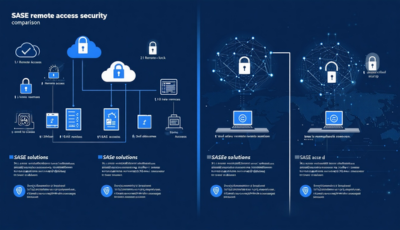The high numbers of people in a work-from-home setting has IT teams working to implement software-defined wide area networking (SD-WAN), secure access service edge (SASE), and artificial intelligence (AI). The end result is that these tools are laying the foundation for an eventual autonomous network.
The building blocks of these components are supporting business continuity throughout the mass exodus from the traditional workplace, but enterprises are largely continuing the transition they were already making to digital environments with IT modernization.
Improving Work-From-Home Connectivity and Security
The combination of SD-WAN, SASE, and AI technologies will act as a springboard for future autonomous networks, eliminating the majority of human errors and creating new efficiencies, thus serving to reduce network outages. Right now, they are improving performance for employees working from home while also improving the need for manual network and security management:
- Work-from-home scenarios are creating an influx of IT tickets, as well as expanding and muddying the network edge. SASE is creating an environment where users can be connected securely from anywhere.
- SD-WAN is also being implemented as a way to introduce application awareness to the network and improve performance and security to home offices.
- IT teams are leveraging machine learning technology and analyzing behaviors in order to better predict bandwidth needs for work-from-home users.
Fueling the Future
Forward-thinking IT teams are beginning to look at the connection between these tools equipping at-home workers and the potential for long-term transformation. A future autonomous network offers connectivity that is self-aware and, eventually, self-driving.
For areas like voice over internet protocol (VoIP), video calls, and ramping for cloud solutions, an autonomous network helps IT teams push toward digital transformation goals without getting tied up in day-to-day management. IT executives spend less time concerned about network performance and can focus on other strategic plans.
Autonomous networks are beginning to look as if they may be in reach sooner than anticipated because the tools are coming together and moving up on the list of priorities. There needs to be accessibility for AI tools to gather raw data from the network in order to apply it in an analytics engine. As enterprises find ways to connect the network to an AI engine, the more autonomous the network can become.
Enterprises will need to eliminate complexity from the underlying IT structures so that the analysis and automation of AI technology isn’t overly complicated. SD-WAN and SASE provide the first step towards the autonomous network because they introduce a software-defined control plane and new levels of agility with integrated security. In addition, the centralized console invites AI tools to gather real-time information to make automated changes based on business policy.To learn more about SD-WAN, SASE, and how equipping employees to work from home is fueling ideas about an autonomous network, contact us at ITBroker.com We can help you envision how these tools might secure your high-performing network today and prepare your enterprise for an autonomous network in the future.





